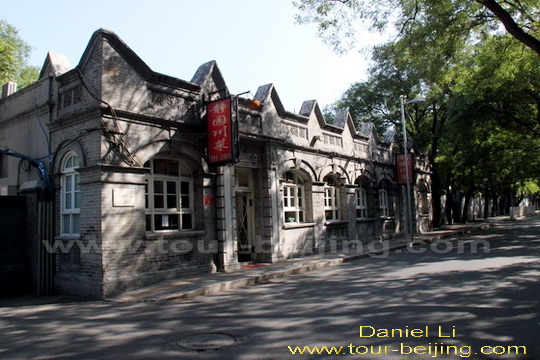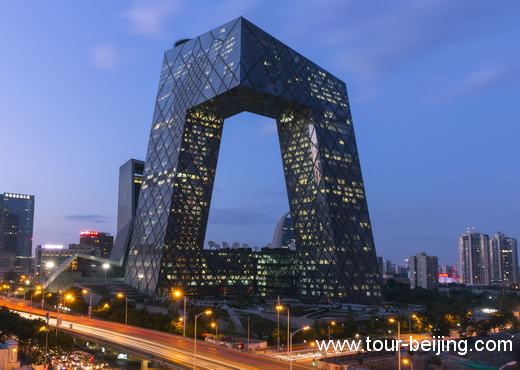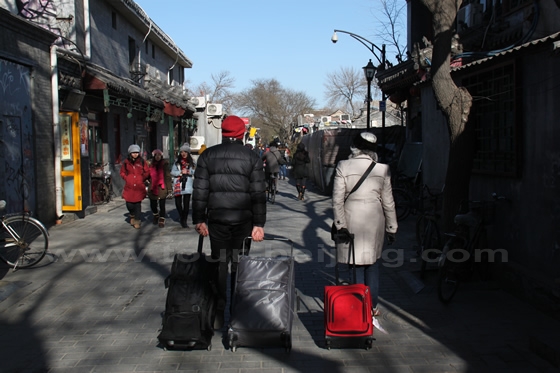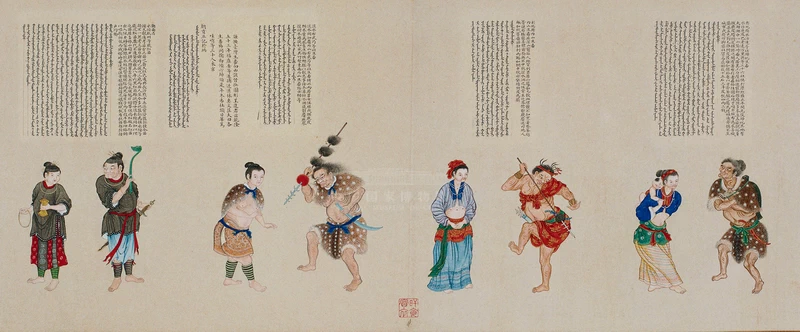Old Beijing folk culture is very precious, both with historical and realistic value. Given Beijing’s political and cultural center status in China, it is bound to have a profound impact on the cultural development of the country. People gradually realize that the rich and profound folk culture of old Beijing rooted in the background of the former imperial city is not only a precious spiritual wealth, but also a great material one.
In the hutongs that crisscross the capital, the people of Beijing have been living here for generations. There are many unique folk customs, and the unique cultures of different nationalities have been interconnected and integrated here.
What do you know about the eight folk cultures with the characteristics of “old Beijing”?
1. The quadrangle courtyard in Beijing
Beijing Siheyuan ( the quadrangle courtyard ) is an inner courtyard compound surrounded by houses on the east, west, south and north sides. Beijing Siheyuan, as the main architectural form of residential buildings for the old beijingers having lived for generations, is well known at home and abroad. It connotes the profound culture.
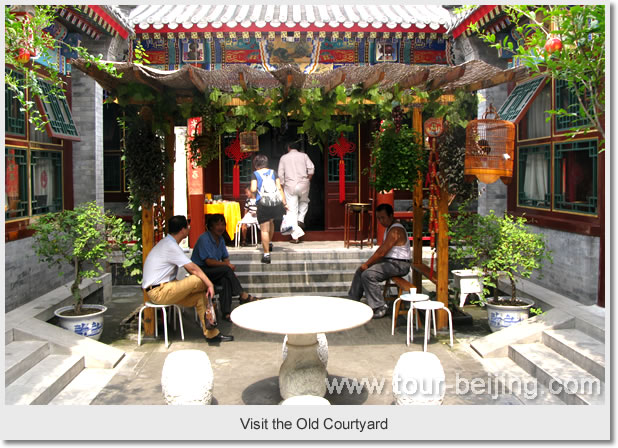
First of all, it has a long history. Siheyuan first appeared during the
large-scale planning and construction of the capital in Yuan Dynasty (1279–1368) together with Beijing’s palaces, yamen, streets, lanes and hutongs at the same time.
Secondly, siheyuan has a unique structure, wide and spacious. Each of its four sides has an independent house, and a verandah is built to connect the four houses, very convenient for living in the compound. The enclosed residence offers much privacy. All the doors to the four houses are open to the courtyard, creating a cozy atmosphere within the family. In the open and spacious courtyard, people still can plant trees and flowers, feeding birds, raising fish etc.
In addition, the decoration, carving, color painting of the courtyard also reflect folk customs and traditional culture everywhere, showing people’s pursuit of happiness, beauty, wealth and auspiciousness, full of strong cultural atmosphere, like a hall of traditional Chinese culture.
2. Hutongs in Beijing
The original meaning of “hutong” derives from the Mongolian word for “well” (daily use of water), which original pronunciation is “hu dong”. Now in Inner Mongolia, there are still many places with “Wells”, such as “sai Yin hu dong” (good Wells) and “ha ye hu dong” (double Wells). Because urban residents cannot live without wells, so there will be wells where people live, hence the names of people where they live. After the mongols established Yuan Dynasty (1279–1368), they also introduced this expression into the central plains, so people gradually used homophonic “hu dong” as “hutong”.
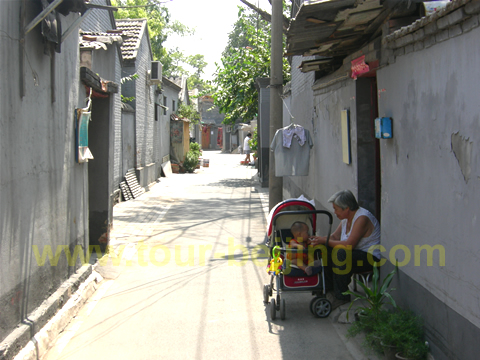
At first glance, the hutongs in Beijing are all gray walls and tiles. Actually not, as long as you are willing to work hard, walking through a few hutongs, and then chatting with the old residents for a while, you will find that each hutong has their own stories, with a legendary experience and a lot of anecdotes.
The hutongs of all sizes in Beijing are scattered all over the original city center, with more than 7,000 hutongs. Most of the hutongs go east or west or south or north. As the saying goes, ” There are three hundred and six lanes ( hutong), and but nameless alley are is countless like a cow’s hair.” The names of hutongs in Beijing vary, and each has its own unique history behind it.
3. Beijing Opera
Among all kinds of art forms, the most representative of traditional Chinese culture should be Beijing Opera. The main feature of Peking Opera is often called “comprehensive drama”, because the creation of Peking Opera is a complete synthesis of dance, song, drama, mime, martial arts and poetry.
Peking Opera is the authentic quintessence of Chinese culture. It has a history of nearly 200 years. It has a beautiful and unique singing and dancing style and incorporates the skills of Chinese martial arts. But its roots go back to several ancient local operas. Its predecessor is hui tone, known as “Pihuang” play.
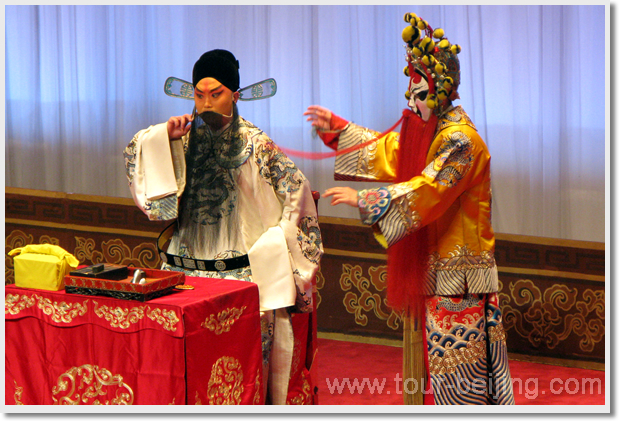
Beijing Opera is accompanied by jinghu, erhu, yueqin, sanxian, flute, suona and drums, gongs, cymbals, etc. The cast are composed of handsome, ugly, good, evil in the light of male, female, old, young. In particular, the facial makeup, which symbolizes character and destiny, is a major feature of Beijing Opera.
Red face represents loyal brave; black face for neutral, on behalf of fierce wisdom; blue and green faces are also neutral, representing the heroes of the jungle; yellow face and white face contain derogatory meaning, representing fierce cheat; the gold and silver faces are mysterious and represent the gods. Magical facial makeup, gorgeous and brilliant clothing, headgear, are themselves precious art forms.
4. Cross Talk in Beijing
Cross talk, a kind of folk rap. It features speaking, learning, amusing and singing. Tianqiao is the birthplace of crosstalk in Beijing. But China’s crosstalk originated from the northern China in Ming and Qing dynasties ( 1368 to 1911), and later became very popular in in Beijing, Tianjin and Hebei, and is now popular all over the country and at home and abroad.
It is mainly spoken in Beijing dialect, and there are cross-talks in local dialect. In the process of the formation of crosstalk, it widely absorbs ventriloquism, storytelling and other arts. Crosstalk has the tradition of “say, learn, amuse, sing” as the main artistic means. “Say” is to tell jokes and play riddles, tongue twisters, etc.; “Learning” is the imitation of a variety of bird and animal calls, cries; Singing and a variety of characters, language, etc.
5. Beijing Tianqiao
Taking about Beijing, you have to mention Tianqiao (Sky Bridge literally). During the late Qing Dynasty (1644-1911) and the Republic of China, the area around Tianqiao flourished and was the center of popular folk culture in Beijing. At that time, Tianqiao was a cluster of taverns, tea houses, acrobatics, folk raps wit a variety of snacks, everything, fortune telling. It actually offered everything, a favorite place for the old Beijing residents to wander. Nowadays, many Beijing citizens still enjoy talking about Tianqiao.
Today Tianqiao’s folk cultue is concentrated in the newly-built Tianquao Music Tea Garden, where people can taste Beijing flavor snacks, over seeing folk performance crosstalk, storytelling and so on.. You can not only appreciate the charm of Beijing folk culture, but also taste the life of the old Beijing.
6. The Temple Fairs in Beijing
Beijing temple fairs are a traditional Chinese folk cultural activity. A temple fair is also known as a temple market or festival. It is a kind of folk collective recreational activity that combines eating, drinking and playing. Because of its origin around temples, the fair is called “temple fare”. Small business vendors saw more and more people burning incense worshipping inside Buddhist temple, they set up a variety of stalls outside temples to earn their money, and gradually the temple fair activity becomes a regular event, so called “meeting or fair”.
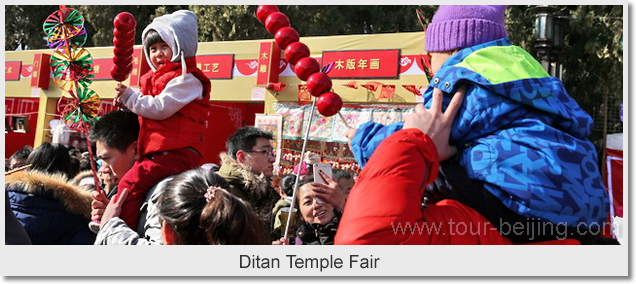
Many temple fairs are usually held during the Spring Festival. A variety of folk art performances, rich Beijing snacks and folk handicrafts are the most attractive for temple fair goers. Yangko dance, stilts, land boat, lion dance, steel fork playing, tiger stick palying, drums, there are more dance “flags”, which is a satin red flag tied on 7 meters long bamboo pole of bowl-like thick, a moment with the hand, a moment with the arm, a moment with the mouth, a moment with the forehead, throwing up and catching, very dangerous.
The most culturally distinctive temple fairs in Beijing include Ditan Temple fair, Longtan Temple Fair, Baiyun Temple fair and Daguanyuan Temple Fair. There are many differences between present temple fairs and the old ones. Eating: Beijing snacks still remain, while adding the regional snacks; Temple fair goers: in the past, the old people brought their children to visit the temple fair; now, it has become a fashion for young people to visit the temple fair.
Performance: in the past the performance was all Beijing flower fair, the form is relatively simple, now the programs from all over the country gather in Beijing temple fairs, the performances are rich and colorful. In the festival, people will take the temple fair as the center, friends gettinh together, the family traveling together, colleagues with each other, enhancing the relationship.
7. The Gates of old Beijing
The gates of old Beijing have so-called “inside nine gates, outside seven gates and imperial city four gates”, with each gate having its own different use.
The “inner nine gates” refer to the nine gates on the inner city, which are respectively the Dongzhi Gate and Chaoyang gate on the east wall in a clockwise direction. Chongwenmen, zhengyangmen and Xuanwumen on the south wall; the west wall has Fuchengmen, Xizhimen; The gate of Desheng and the Gate of Anding on the north wall.
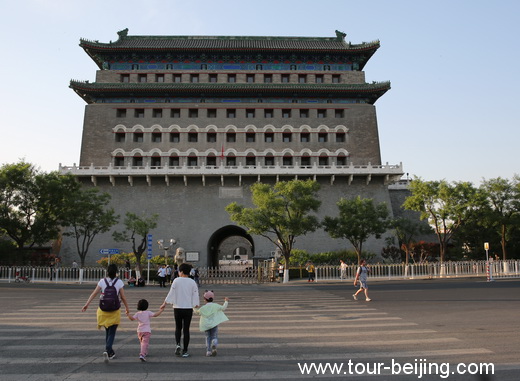
All the original nine gates now snake within the edge of the second ring road in Beijing. Dongzhimen in Ming Dynasty was known as Chongren Gate was used for carts transporting wood charcoal, called Wood Road. Chaoyangmen in Ming Dynasty known as Qihuamen was used as a grain passage. The Gate of Chongwen is also called the gate of hade, which was the passage for transporting wine in the past.
Qianmen Gate is called zhengyang gate, was for the emperor in and out of the gate, whike the civilians were forbiden to to through, and could only go through the moon gates by the side of Qianmen. Xuanwumen called Shunzhi Gate, where the prisoners were dragged from the gate, pulling to the Caishikou and beheaded.
Fuchengmen at that time called Pingcemen, was the coal passage. Xizhimen in Ming Dynasty known as the Heyi gate, was the water channel, every day early in the morning water carried from the Yuquan Mountain through Heyi Gate into the city of Beijing, into the imperial city. Deshengmen was the gate through which victorious troops returned. Andingmen was the gate through which troops went out to battle.
“Outer seven gates”, Yongding Gate, Zuo-an Gate, You-an gate, Guangqumen Gate, Guanganmen, Dongbianmen, Xibianmen, which were used for local residents to go into the city to do small business, temporary work, and visit relatives.
“Imperial city four gates”, Tiananmen, Dianmen, Donganmen, Xi ‘an men, these four gates were for the city’s civil offcials and military officers in and out of the palace.
8. Marriage Customs in Beijing
A custom of marriage is not unique to a city or a county. This is true in most parts of the country in the past, and old Beijing was no exception. In the north China, if you wanted to remember a person’s age, the most important was to keep in mind the twelve zodiac signs. Especially in the marriage event, the male and female could get married if their born years of the zodiac signs are compatible.
After the engagement was confirmed, the men’s family would choose a good day, with a red card (marriage letter) for the engagement in the wedding. Men’s family would send women’s home clothes, jewelry, wine, fruits, cakes and other gifts, which were called the engagement ceremony, but this was only a small gift. The wedding date before a month,men’s family had to send a big gift, generally including something to eat, clothes to wear, wine to drink, live geese, and so on.
Tip: Hassle-free Beijing Guided Tours
If you don’t want to go the do-it-yourself route and prefer the hassle-free escorted tours, here are some options for Beijing guided tours:
Car Rental in Beijing
Beijing Day Tour
Beijing Tour Packages
Beijing Winter Tour
Great Wall Tour
Beijing Tours
China City Tours
China Tour
Further Readings
Best Time to Visit Beijing
How to plan a trip to Beijing
Top 10 Attractions in Beijing
How to Visit Forbidden City
How to Visit Temple of Heaven
How to Visit Summer Palace
How to Visit Ming Tombs
How to Visit the Great Wall of China
How to Visit Tiananmen Square
How to Visit Hutongs
How to Visit Olympic Sites
Top 10 Markets in Beijing
Top 10 Shopping Malls in Beijing
Beijing Shopping
Wangfujing Walking Street
Qianmen Commercial Street
Gui Jie ( Ghost Street) Food Street
Any questions, just drop a line.






